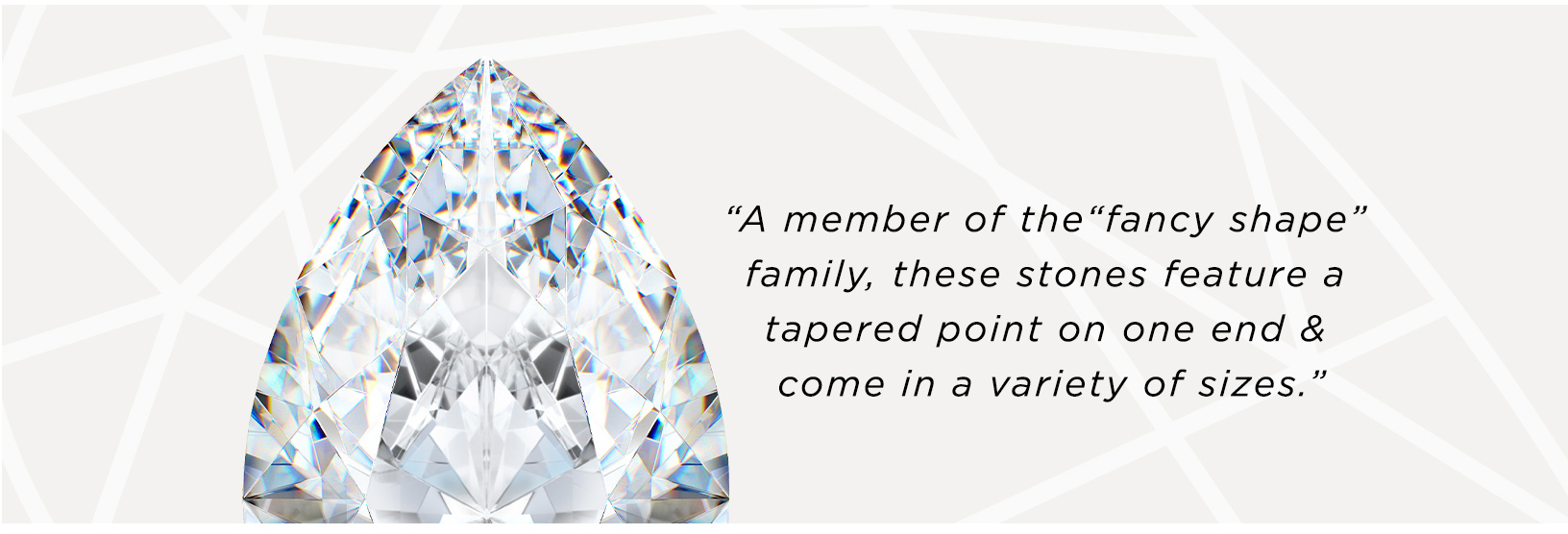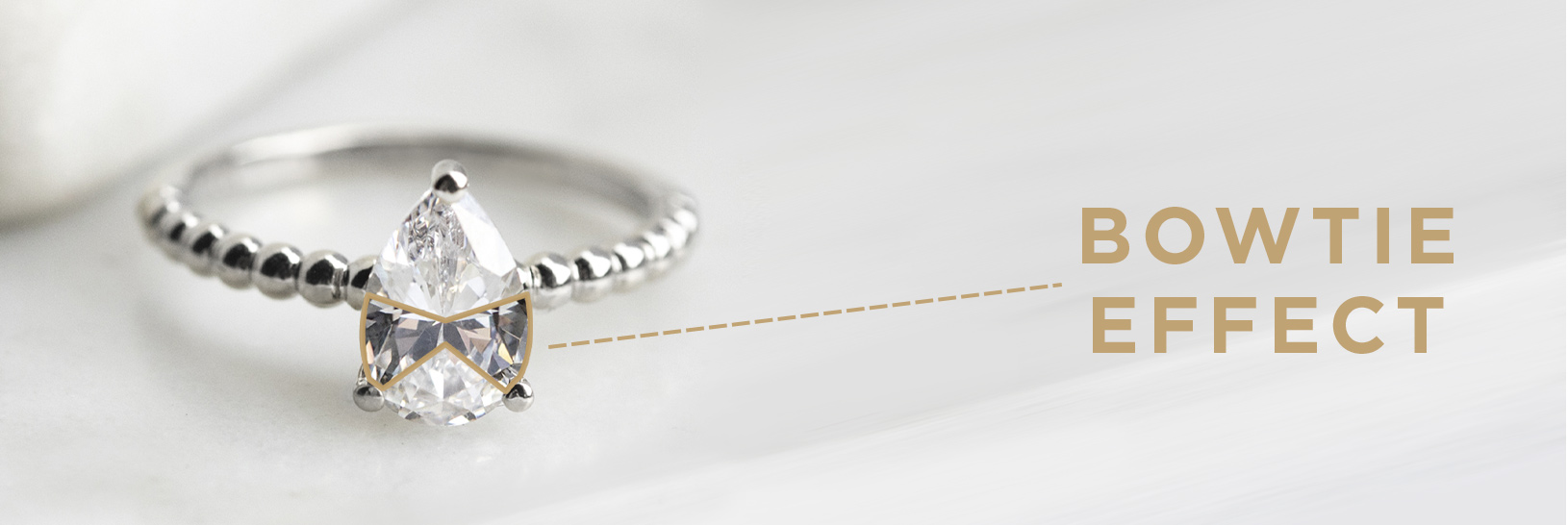Pear Shaped Engagement Ring Meaning
April 6th, 2021 / Alese Oldenburg
Bold, bright and beautiful, pear cut diamonds are among the most captivating of stone shapes. A one-of-a-kind style that features some of the best diamond cutting techniques, a quality pear cut stone is guaranteed to turn heads. If you’re in the market for a diamond engagement ring and have your heart set on this distinctive style you’ve come to the right place.

In this article, we’ll discuss everything that you need to know before making your diamond purchase. From the meaning and history of this iconic shape to tips to help you find the highest quality stone. Let’s dive into the pear cut engagement ring meaning.
What Is a Pear Shaped Diamond
If you are browsing Engagement rings and want a ring that truly stands out, a pear cut diamond is a great place to begin your search. Pear shaped diamonds feature design elements taken from the famed round brilliant cut and the eye-catching marquise cut. A member of the “fancy shape” family, these stones feature a tapered point on one end and come in a variety of sizes. Thanks to their elongated shape, pear cut diamonds make the wearer’s fingers appear longer and more slender.

Whether you are reading this article to understand the significance behind the pear shape itself or discover the pear shaped wedding ring meaning, you know that these stones have a one-of-a-kind cut. You might also hear pear shaped stones referred to as teardrop diamonds as their unique design recalls thoughts of tears of joy associated with love and marriage. Additionally, a pear cut stone is thought to represent a wearer that walks to the beat of their own drum. The pear cut stands out from the crowd and is perfect for the person with a flair for individuality, romance and elegance. A teardrop diamond is a unique stone shape indeed.
Pear Shaped Diamond History
While popular in many modern engagement ring designs, pear shaped diamonds aren’t new to the fine jewelry game. In fact, this captivating stone dates back to the mid-15th century when a Belgian diamond cutter named Lodewyk Van Bercken invented the diamond-polishing wheel. Van Bercken dubbed his creation the “scaif” and embarked on a diamond polishing journey that would result in the origin of several complex cuts and shapes. Among Van Bercken’s new creations was the world’s first pear shaped diamond.
Pear Shaped Diamonds Today

Sometimes overlooked, designs featuring a pear cut center stone aren’t as popular as their princess cut, cushion cut and round diamond counterparts. However, pear shaped stones are having a moment as celebrities like Ariana Grande and Victoria Beckham embrace the unique style and radiant cut. If you are wondering how to wear a pear shaped ring, see our blog for more information.
Pear Shaped Diamond Quality
Length to Width Ratio
Over the years, diamond cutters have attempted to find the ideal ratio for a pear cut stone but none could find a combination of length to width better than Van Bercken’s original 58 facets.
Most pear shaped diamonds on today’s market are polished into three distinct ratio ranges: 1) 1 – 1:30 which is a semi-pudgy pear, 2) 1 – 1:50 the most common and attractive cut, and 3) 1 – 1:70 an elongated style. Deciding which cut is right for you comes down to a matter of personal preference. However, some diamond cutters choose to go outside of these proportions.

If you are browsing gemsociety.org explains it like this, “Diamond cutters looking at a rough crystal often chose weight-saving cuts over beauty. In the bid for weight retention, they may decide that an out of ideal shape will still be salient.”
In addition to a well-proportioned stone, if you’re shopping for a pear shaped gem you’ll want to look for a well-rounded diamond. The sides of the stone should be full and symmetrical with no flattened areas or bulges that are too far out of symmetry. A pear cut diamond should showcase the best of a round brilliant cut’s symmetry in its belly and shoulders while the marquise features should be seen towards the stone’s point.
The Bow-Tie Effect
No matter the stone you choose, you’ll want to speak to your jeweler or a gemologist to check your pear cut diamond for light leakage. An undesirable trait unique to some fancy shapes, light leakage occurs when a dark bow-tie shape is present in the middle of the diamond. This prevents the optimum light return back to the eye and is referred to as the bow-tie effect.

Some bow-ties are noticeable even to the untrained eye, while others can sneak under the radar. For the best bang for your buck, avoid large, dark bow-ties and make sure that the center of your stone gives off some sparkle. If the diamond doesn’t sparkle it probably isn’t worth your money.
Carat Weight
Due to their elongated shape, pear cut or teardrop cut diamonds appear larger than stones of a similar size and carat weight. Pear shapes allow for greater surface area visibility resulting in a bigger and more impressive appearance than other traditional styles.
 This nifty trick makes pears a fabulous stone for people on a budget. Likewise, those searching for a center stone that will really impress are sure to be pleased with a pear cut diamond.
This nifty trick makes pears a fabulous stone for people on a budget. Likewise, those searching for a center stone that will really impress are sure to be pleased with a pear cut diamond.
Cost
In addition to a perceived larger carat weight, trendy pear cut gemstones also tend to cost less than other styles. In fact, the International Gem Society reports that pear shaped diamonds cost 10 to 30% less on average when compared to a round brilliant cut stone of similar size.
Disadvantages
Unfortunately, the pretty pear shaped diamond doesn’t come without its cons. The tip of a pear cut diamond is known to be fragile and prone to chipping. Additionally, a well-cut pear can be hard to come by. The Gemological Institute of America(GIA) has yet to assign quality grades for fancy shaped diamonds such as emerald, Asscher, marquise and pear so it will be up to you to examine your diamond’s shape and sparkle.
Pear Shaped Diamond Engagement Ring Settings
Pear diamonds should always be set with a prong at the pointed end of the stone to prevent chipping. If the point of a pear cut stone is left uncovered you run the risk of it catching or snagging on everyday objects like hair and clothing. Because of this, the most popular settings for pear cut engagement rings are the six-prong setting and the five-prong setting. Each of these styles will provide the proper protection to keep your diamond safe and intact.
 Alternatively, a halo setting can also protect the fragile pointed tip of a pear cut diamond. In a halo setting the center stone is completely encircled by a surrounding layer of accent stones. The result is a blinged-out engagement ring that offers added protection to delicate stones.
Alternatively, a halo setting can also protect the fragile pointed tip of a pear cut diamond. In a halo setting the center stone is completely encircled by a surrounding layer of accent stones. The result is a blinged-out engagement ring that offers added protection to delicate stones.
Another safe choice for your beloved pear diamond is the bezel setting. This style offers the best possible protection for any diamond shape as the entire perimeter of the stone is wrapped in metal to keep it in place. Bezel settings offer a modern charm that pairs well with minimalistic styles. However, a bezel setting can make your diamond look smaller than a prong setting as the sides of the stone are hidden.
Read our blog on the best pear shaped diamond ring settings to learn more!
Sources:
The History of Pear Shaped Diamonds
Different Diamond Shapes: Ultimate Guide with Size & Price Chart
*Here at Diamond Nexus, we strive to provide valuable information while being clear and honest about our products. The Nexus Diamond™ alternative is a patented lab created diamond simulate that, among all simulants, most closely imitates the look, weight and wear of a diamond, with two exceptions – it is absolutely perfect in every way, and it costs significantly less. Price points and environmental facts expressed in this blog were taken from popular online retailers and may vary. Learn more about the environmental impact of mining by visiting our blog.

